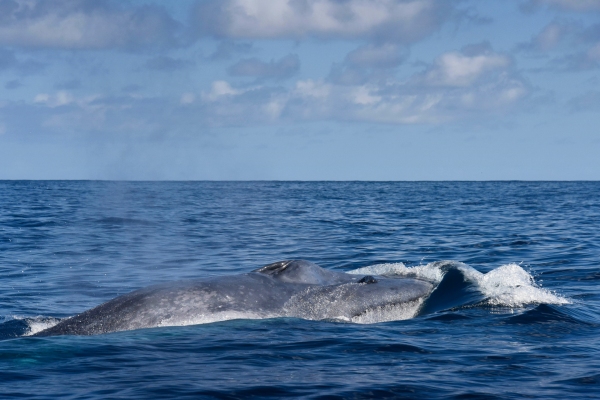A two-week expedition to tag blue whales in New Zealand waters for the first time, almost came up empty due to warmer sea temperatures causing the animals to change their behaviour.
NIWA megafauna expert and marine ecologist Kim Goetz led the expedition hoping to tag up to eight blue whales to help understand their foraging and migration patterns. The tags transmit location data via satellite.
The original plan was to locate and tag the whales in Cook Strait and off the coast of south Taranaki.
“We have little idea about how these whales use these regions, including movements in and out of the area, which has important management implications.
“Usually when whales are found off Taranaki, there’s a lot of upwelling going on and the waters are around 13-16°C. But we had water temperatures of 20-22°C and we are currently in a La Niña weather pattern, which is not conducive to upwelling of nutrients in the Cook Strait region,” Dr Goetz said.
Upwellings occur when deep cold water rises to the surface. This water is rich in nutrients and plays an important role in the productivity of the ecosystem, which ultimately influences the movement of marine animals.
“We spent the first couple of days searching the area off Taranaki where we suspected the blue whales would be but just came up empty. Near Farewell Spit a pilot from Golden Bay Air found one animal but it was heading south in a hurry.
“We had a report that blue whales were seen in the Hokitika Canyon, south of Greymouth, so at that point we decided to head further down the west coast.”
While sheltering from bad weather in Westport, Dr Goetz and her team, comprising researchers from the Department of Conservation and Blue Planet Marine, spoke to tuna fishermen who reported having to head south to fish much sooner in the year than normal due to abnormally high sea temperatures in the north.
“When the weather improved we hired a plane to search for whales in offshore waters down to the Hokitika Canyon while our boat headed south at the same time. Both the fishermen and the pilot confirmed that the whales were 20 to 30 nautical miles offshore from Westport. Sure enough, we found the blues in among the tuna vessels, but it was like finding a needle in a haystack with this La Niña weather pattern.”
The water was thick with gelatinous salps, which are 95% water and not nutritious enough to sustain whales, but there were no krill at the surface so the whales were feeding at depth— staying down for up to 10 minutes at a time.
“They usually breathe at the surface four or five times and then they’re down. If they’re appearing 300m from your boat when they surface, by the time you get to them they’re down again. “Despite it being really difficult to get near them, we were able to attach tracking devices to two whales which, on reflection was really good. We thought at first we weren’t going to get any instruments deployed at all.”
The tracking devices, which should last for four to six months, show both whales are now heading north, with one bypassing the Taranaki region.
“We have no idea where these animals are heading but the tags are transmitting well and it has all been worth it,” Dr Goetz said.
“This will give us novel information as it is the first movement data for this species in New Zealand waters which is very exciting.”
The NIWA research expedition was also supported by OMV, University of Auckland, the Australian Antarctic Division, Western Work Boats, Oregon State University and the Pew Charitable Trust.

